Mirror Coatings Market
Mirror Coatings Market Size and Share Forecast Outlook 2025 to 2035
Mirror coatings market is projected to grow from USD 0.9 billion in 2025 to USD 1.5 billion by 2035, at a CAGR of 5.4%. Polyurethane will dominate with a 46.4% market share, while water-based coatings will lead the application segment with a 40.5% share.
Mirror Coatings Market Forecast and Outlook 2025 to 2035
The global mirror coatings market is projected to reach USD 1.46 billion by 2035, recording an absolute increase of USD 0.6 billion over the forecast period. The market is valued at USD 0.86 billion in 2025 and is set to rise at a CAGR of 5.4% during the assessment period.
The overall market size is expected to grow by approximately 1.7 times during the same period, supported by expanding architectural glass applications across residential and commercial construction worldwide, driving demand for reflective surface coatings in interior design and building facade installations, and increasing investments in solar energy infrastructure with specialized mirror coating technologies across photovoltaic and concentrated solar power applications globally.
Quick Stats for Mirror Coatings Market
- Mirror Coatings Market Value (2025): USD 0.86 billion
- Mirror Coatings Market Forecast Value (2035): USD 1.46 billion
- Mirror Coatings Market Forecast CAGR: 5.4%
- Leading Resin Type in Mirror Coatings Market: Polyurethane (46.4%)
- Fastest Growing Resin in Mirror Coatings Market: Acrylic (6.2% CAGR)
- Leading Application in Mirror Coatings Market: Water-based Coatings (40.5%)
- Leading End Use in Mirror Coatings Market: Architectural (58.8%)
- Key Growth Regions in Mirror Coatings Market: Asia Pacific, Europe, and North America
- Top Players in Mirror Coatings Market: SHERWIN-WILLIAMS, Edmund Optics Inc., Arkema, Pearl Nano, Diamon-Fusion International, Inc., FENZI S.p.A., General Optics (Asia) Limited, Guardian Industries, JENOPTIK AG, North America Coating Laboratories, AccuCoat Inc., CASIX, Inc., Abrisa Technologies
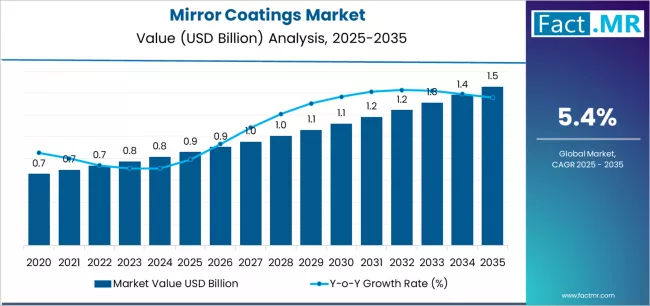
Architects and building contractors face mounting pressure to deliver energy-efficient glazing solutions and enhance aesthetic appeal while meeting sustainability standards and durability requirements, with modern mirror coatings providing documented performance advantages including superior reflectivity, corrosion resistance, and weather protection compared to conventional silvering processes alone.
Rising demand for smart mirror technologies and expanding automotive applications enabling advanced display integration create substantial opportunities for coating manufacturers and glass processors. However, raw material price volatility and environmental regulations governing VOC emissions may pose obstacles to traditional coating formulation approaches.
The polyurethane resin segment dominates market activity with a 46.4% market share, driven by extensive adoption in protective topcoat applications and moisture barrier systems requiring superior adhesion across diverse mirror substrate materials worldwide. Coating formulators increasingly recognize the performance benefits of polyurethane-based systems, with typical product offerings providing effective chemical resistance, UV stability, and mechanical durability at competitive formulation costs through established coating supply networks.
The water-based coatings application segment demonstrates substantial market presence with 40.5% share, supported by environmental regulations and sustainability initiatives requiring low-VOC formulations in architectural and decorative mirror production. The architectural end-use segment emerges as the dominant category with a 58.8% market share, reflecting industry concentration in residential bathroom mirrors, commercial building facades, and interior design applications requiring diverse mirror coating solutions. Acrylic resins represent the fastest-growing segment, driven by enhanced optical clarity and improved weatherability supporting outdoor architectural applications.
Regional dynamics show Asia Pacific maintaining the fastest growth trajectory, supported by rapid urbanization and expanding automotive production across emerging economies. Europe demonstrates strong market presence driven by stringent environmental standards and smart coating technology adoption, while North America emphasizes renovation activities and automotive innovation.
China leads country-level growth with 6.0% CAGR through solar power expansion and low-emission construction initiatives, while Asia Pacific region overall shows 5.8% CAGR supported by manufacturing capacity and infrastructure development. The competitive landscape features moderate concentration with Sherwin-Williams maintaining 12.3% market leadership position, while established coating companies including Edmund Optics Inc., Arkema, Pearl Nano, and Diamon-Fusion International, Inc. compete through technological innovation, environmental compliance, and specialized coating formulations across architectural, automotive, and solar energy applications.
Mirror Coatings Market Year-over-Year Forecast 2025 to 2035
Between 2025 and 2029, the mirror coatings market is projected to expand from USD 0.86 billion to USD 1.06 billion, resulting in a value increase of USD 0.2 billion, which represents 33.1% of the total forecast growth for the period. This phase of development will be shaped by rising demand for low-VOC architectural coatings in green building projects, product innovation in nanotechnology-based protective layers with enhanced durability and self-cleaning properties, as well as expanding integration with smart mirror technologies and energy-efficient glazing systems. Companies are establishing competitive positions through investment in waterborne coating formulations, advanced application equipment, and strategic market expansion across architectural glass processors, automotive OEM suppliers, and solar panel manufacturers.
From 2029 to 2035, the market is forecast to grow from USD 1.06 billion to USD 1.46 billion, adding another USD 0.4 billion, which constitutes 66.9% of the overall expansion. This period is expected to be characterized by the expansion of specialized coating applications, including anti-fog and anti-bacterial mirror surfaces tailored for healthcare and automotive sectors, strategic collaborations between coating manufacturers and glass fabricators, and an enhanced focus on circular economy principles and coating recyclability. The growing emphasis on digitally-integrated mirror systems and rising adoption of solar concentrator technologies will drive demand for high-performance mirror coatings across diverse architectural and industrial applications.
Mirror Coatings Market Key Takeaways
| Metric | Value |
|---|---|
| Market Value (2025) | USD 0.86 billion |
| Market Forecast Value (2035) | USD 1.46 billion |
| Forecast CAGR (2025-2035) | 5.4% |
Why is the Mirror Coatings Market Growing?
The mirror coatings market grows by enabling glass manufacturers, architects, and building contractors across residential construction, commercial developments, and industrial applications to deliver durable reflective surfaces and achieve long-lasting performance while protecting mirror substrates without the limitations associated with traditional silvering processes.
Glass processors face mounting pressure to meet environmental regulations and ensure product longevity while managing production costs and maintaining optical quality, with modern mirror coating systems typically providing targeted protective characteristics including corrosion resistance against moisture and chemicals, enhanced adhesion through multi-layer formulations, and UV stability preventing degradation through advanced resin technologies compared to single-layer protective coatings alone, making sophisticated mirror coatings essential for reliable mirror manufacturing.
The glass industry's need for environmentally compliant and high-performance coating solutions creates demand for specialized mirror coating formulations that can deliver consistent quality, support diverse substrate materials, and meet stringent regulatory requirements without compromising production efficiency or optical properties.
Architectural specification and expanding construction activity drive utilization in residential bathrooms, commercial interiors, and building facades, where coating performance has direct impact on mirror lifespan and customer satisfaction. The growing global construction output, particularly across Asia Pacific emerging markets experiencing rapid urbanization and middle-class growth, creates expanding opportunities for architectural mirror coatings.
Rising building owner emphasis on sustainable materials and LEED certification enables informed specification of low-VOC water-based mirror coating systems. However, raw material costs for silver, resins, and specialized additives may limit margin expansion among coating manufacturers facing commodity price fluctuations and competitive pricing pressures across different regional markets with varying quality expectations.
Segmental Analysis
The market is segmented by resin, application, end use, and region. By resin, the market is divided into polyurethane, epoxy, acrylic, and others. Based on application, the market is categorized into water-based coatings, solvent-based coatings, nanotechnology-based coatings, and others.
By end use, the market includes architectural, automotive & transportation, decorative, solar power, and others. Regionally, the market is divided into Asia Pacific, Europe, North America, Latin America, and Middle East & Africa.
By Resin, Which Segment Accounts for the Dominant Market Share?
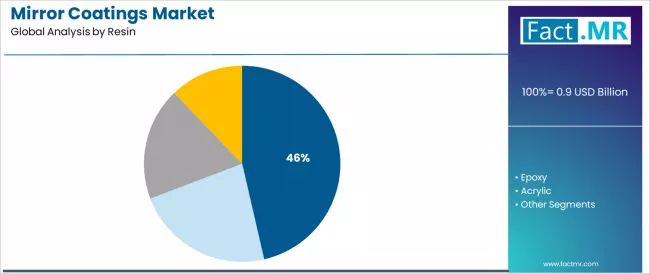
The polyurethane segment represents the dominant force in the mirror coatings market, capturing 46.4% of the total market share in 2025. This established resin category encompasses solutions featuring flexible coating films and superior protective properties, including advanced two-component systems combining polyol and isocyanate components with cross-linking mechanisms that enable excellent adhesion, chemical resistance, and mechanical durability across glass mirror substrates in architectural, automotive, and decorative applications worldwide.
The polyurethane segment's market leadership stems from its versatile performance characteristics, with coating formulations capable of addressing critical mirror protection requirements including moisture barrier effectiveness, scratch resistance, and long-term weatherability while maintaining excellent optical clarity and substrate compatibility standards across diverse manufacturing environments.
Within this segment, polyurethane topcoats represent the largest application category, driven by protective overcoat requirements for silvered mirrors preventing oxidation and environmental damage. This sub-segment benefits from established formulation chemistry and proven field performance supporting consistent specification.
The epoxy segment maintains substantial presence serving applications requiring exceptional chemical resistance and adhesion strength for industrial mirrors and specialized optical applications. These solutions offer robust protective properties for manufacturers managing harsh environmental exposures while providing sufficient flexibility to accommodate substrate thermal expansion.
The acrylic segment demonstrates the fastest growth trajectory with 6.2% CAGR, driven by enhanced UV resistance, excellent optical clarity, and favorable environmental profiles supporting outdoor architectural applications and automotive exterior mirrors. This segment benefits from continuous innovation in waterborne acrylic formulations supporting VOC compliance.
Key performance advantages driving the polyurethane segment include:
- Advanced protective capabilities with documented moisture barrier properties preventing silver layer corrosion and delamination across diverse humidity conditions
- Established flexibility characteristics enabling stress accommodation during thermal cycling and substrate movement without coating failure
- Enhanced chemical resistance features providing protection against cleaning agents, atmospheric pollutants, and industrial chemicals while maintaining coating integrity
- Superior application versatility allowing spray, roll, or curtain coating methods supporting diverse manufacturing scales and automation levels
By Application, Which Segment Accounts for the Largest Market Share?
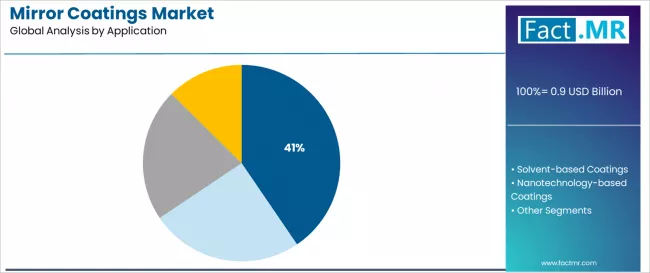
Water-based coatings applications dominate the mirror coatings formulation landscape with approximately 40.5% market share in 2025, reflecting the critical role of low-VOC systems in supporting environmental compliance and workplace safety across mirror manufacturing facilities worldwide. The water-based coatings segment's market leadership is reinforced by regulatory pressures limiting solvent emissions, growing customer preference for sustainable products, and technological advancement enabling performance parity with traditional solvent systems.
Within this segment, waterborne polyurethane systems represent significant formulation approaches, driven by architectural mirror production requiring environmental compliance and worker safety. This sub-segment benefits from established supplier infrastructure and comprehensive technical support enabling successful formulation transitions.
The solvent-based coatings segment represents meaningful market presence with the fastest growth rate of 5.8% CAGR through specialized requirements for automotive mirrors and industrial applications demanding superior flow characteristics and rapid curing capabilities. This segment benefits from established performance advantages including excellent substrate wetting and optimal film formation.
The nanotechnology-based coatings segment demonstrates innovative growth through applications in self-cleaning mirrors, anti-fog automotive mirrors, and enhanced durability solar reflectors where nanoparticle incorporation provides unique functional properties. Others category serves specialized applications including powder coatings and UV-curable systems.
Key market dynamics supporting application growth include:
- Water-based segment expansion driven by environmental regulations and sustainability initiatives, requiring advanced formulation technologies matching solvent-based performance
- Solvent-based segment resilience through automotive OEM specifications and industrial application requirements demanding specific performance characteristics
- Nanotechnology integration enabling functional surface properties including self-cleaning, anti-bacterial, and enhanced scratch resistance through nanoparticle incorporation
- Growing emphasis on hybrid coating systems combining water-based environmental benefits with performance-enhancing additives achieving optimal property balance
By End Use, Which Segment Accounts for a Significant Market Share?
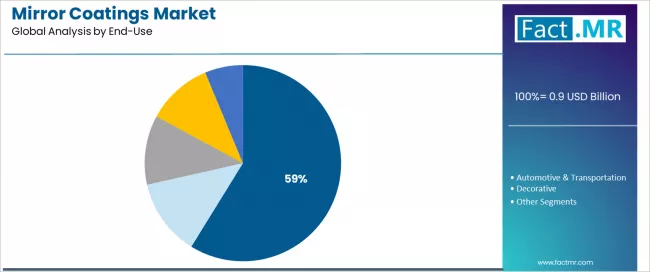
Architectural applications represent the leading end-use segment in the mirror coatings market with approximately 58.8% market share in 2025, reflecting the extensive mirror utilization in residential bathrooms, commercial building interiors, retail fitting rooms, and building facade installations. The architectural segment demonstrates consistent demand driven by residential construction activity, commercial real estate development, and renovation projects requiring diverse mirror products across price points and quality levels.
Within the architectural segment, residential bathroom mirrors represent the largest application category, driven by new home construction and remodeling activity requiring standard and custom mirror products. This sub-segment benefits from established distribution channels and consumer preference for quality reflective surfaces.
The automotive & transportation segment emerges as an important category with substantial growth potential, driven by vehicle production requiring interior and exterior mirrors with specialized coating systems providing enhanced durability and functionality. Electric vehicle growth accelerates demand for lightweight mirrors with integrated display technologies.
The decorative segment maintains meaningful presence through furniture applications, art installations, and specialty design projects requiring custom mirror treatments. Solar power applications demonstrate strategic importance through concentrated solar power installations and photovoltaic module production requiring precision reflective coatings.
Key end-use dynamics include:
- Architectural dominance requirements accelerating across residential and commercial construction with emphasis on moisture-resistant bathroom mirrors and aesthetic interior design applications
- Automotive applications driving demand for functional coatings including anti-glare, heated mirrors, and smart mirror displays with integrated electronics
- Solar power segment expansion reflecting concentrated solar power plant development and heliostat mirror requirements for renewable energy infrastructure
- Decorative applications emphasizing custom finishes, antiqued effects, and artistic mirror treatments supporting interior design differentiation
What are the Drivers, Restraints, and Key Trends of the Mirror Coatings Market?
The market is driven by three concrete demand factors tied to construction and manufacturing activity. First, rising global construction output and urbanization trends create expanding mirror demand, with protective coatings representing a critical requirement for ensuring product durability, requiring widespread adoption in architectural glass manufacturing. Second, growing environmental regulations and sustainability standards drive transition to water-based coating systems, with numerous jurisdictions implementing VOC emission limits and green building requirements accelerating low-solvent formulation adoption by 2030. Third, increasing automotive production and smart mirror technology integration enable more sophisticated applications that improve vehicle safety and user experience while supporting connected vehicle features through coated mirror substrates.
Market restraints include raw material price volatility and supply chain dependencies that can challenge coating economics and profitability, particularly where silver prices, titanium dioxide costs, and specialty resin availability fluctuate significantly affecting manufacturing costs. Environmental compliance costs and reformulation requirements pose another significant obstacle, as coating manufacturers must invest in R&D, testing, and production equipment modifications to meet evolving VOC regulations and performance specifications, potentially affecting competitive positioning. Limited differentiation among standard products and pricing pressures in commodity mirror segments create additional challenges for premium pricing, demanding innovation in functional coatings and value-added features.
Key trends indicate accelerated smart mirror adoption in developed markets, particularly North America and Europe, where manufacturers demonstrate commitment to integrating display technologies, touch sensors, and connectivity features. Nanotechnology integration trends toward self-cleaning surfaces, anti-bacterial properties, and enhanced durability enable functional value propositions that optimize user experience and maintenance reduction. However, the market thesis could face disruption if significant advances in alternative reflective technologies or major shifts toward frameless architectural glass designs reduce reliance on traditional mirror coating approaches.
Analysis of the Mirror Coatings Market by Key Countries
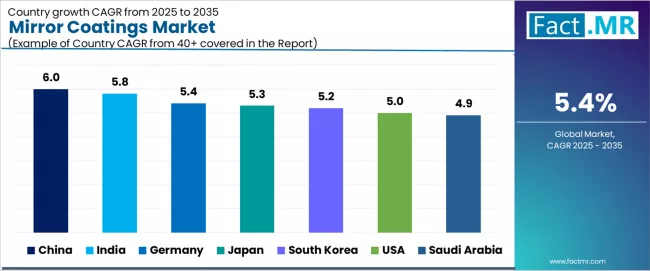
| Country | CAGR (2025 to 2035) |
|---|---|
| China | 6.0% |
| India | 5.8% |
| Germany | 5.4% |
| Japan | 5.3% |
| South Korea | 5.2% |
| USA | 5.0% |
| Saudi Arabia | 4.9% |
The global mirror coatings market is expanding steadily, with China leading at a 6.0% CAGR through 2035, driven by solar power infrastructure expansion, concentrated solar power plant development, and low-emission construction initiatives supporting sustainable building practices. India follows at 5.8%, supported by rapid urbanization, construction boom, and residential & commercial mirror demand across growing cities.
Germany records 5.4%, reflecting sustainable construction practices with automotive industry integration and smart mirror technology adoption. Japan advances at 5.3%, leveraging advanced manufacturing capabilities and precision automotive mirror production supporting high-quality residential and commercial projects.
South Korea posts 5.2%, focusing on automotive industry growth and premium commercial mirror applications in smart city development programs, while USA grows at 5.0%, emphasizing energy-efficient buildings and LEED certification programs driving automotive mirror innovation. Saudi Arabia demonstrates 4.9% growth, anchored by urban infrastructure investments and solar energy projects supporting high-end commercial and residential development.
How is China Leading Global Market Expansion?
China demonstrates the strongest growth potential in the mirror coatings market with a CAGR of 6.0% through 2035. The country's leadership position stems from massive solar energy infrastructure development, concentrated solar power plant installations, and government initiatives promoting low-emission construction practices driving specialized mirror coating demand. Growth is concentrated in major manufacturing regions and renewable energy zones, including Jiangsu, Guangdong, Zhejiang, and Inner Mongolia, where glass processors and coating manufacturers are increasingly producing architectural mirrors, automotive mirrors, and solar reflectors across residential construction projects, commercial developments, and renewable energy installations.
Distribution channels through building material markets, automotive supply chains, and solar equipment manufacturers expand market penetration across diverse end-user segments and regional markets. The country's extensive glass manufacturing capacity and vertical integration from float glass production through mirror coating provides strong momentum for cost-competitive supply, including comprehensive coverage across budget residential mirrors and precision solar reflector applications.
Key market factors:
- Solar energy expansion concentrated in western provinces and Inner Mongolia with concentrated solar power plants requiring precision heliostat mirrors
- Construction activity in tier-1 and tier-2 cities supporting architectural mirror demand for residential and commercial building projects
- Automotive production infrastructure through domestic manufacturers requiring interior and exterior mirror coatings for passenger vehicles
- Government initiatives including carbon neutrality targets and green building standards driving low-VOC coating adoption and sustainable manufacturing practices
Why is India Emerging as a High-Growth Market?
In major metropolitan areas including Mumbai, Delhi NCR, Bangalore, Chennai, and Hyderabad, the adoption of mirror coating solutions is accelerating across residential construction, commercial real estate developments, and infrastructure projects, driven by rapid urbanization and expanding middle-class consumption. The market demonstrates strong growth momentum with a CAGR of 5.8% through 2035, linked to construction boom across major cities and increasing focus on quality building materials in residential and commercial segments.
Indian glass manufacturers and coating suppliers are implementing modern mirror coating facilities and quality control systems to support domestic construction demand while establishing competitive pricing structures for growing markets. The country's expanding residential construction creates ongoing demand for bathroom mirrors and decorative applications, while commercial real estate growth drives architectural mirror utilization in office buildings, hotels, and retail centers.
Key development areas:
- Residential construction boom leading architectural mirror demand with emphasis on bathroom renovations and new home developments
- Commercial real estate expansion supporting large-scale mirror installations in corporate offices, shopping malls, and hospitality projects
- Urbanization trends driving housing demand across tier-1, tier-2, and tier-3 cities requiring quality bathroom fixtures and interior finishes
- Growing middle class emphasizing quality residential finishes and modern bathroom amenities supporting premium mirror product adoption
What Drives Germany’s Market Resilience?
Germany’s market expansion is driven by diverse requirements, including sustainable construction projects emphasizing environmental compliance and advanced automotive manufacturing requiring precision mirror systems. The country demonstrates strong growth potential with a CAGR of 5.4% through 2035, supported by green building initiatives and continuous automotive innovation across major industrial regions.
German manufacturers face implementation challenges related to strict environmental regulations and automotive quality standards, requiring coating formulations demonstrating clear sustainability credentials and comprehensive performance verification. However, established architectural glass industry and premium automotive sector create stable baseline demand for advanced mirror coatings, particularly among green building projects and automotive OEM suppliers where proven performance and technical certification drive specification decisions and long-term supply relationships.
Market characteristics:
- Sustainable construction initiatives and KfW green building programs driving water-based coating adoption across residential and commercial projects
- Automotive industry concentration supporting specialized mirror coating requirements for passenger vehicles and commercial transportation
- Smart mirror technology development through German engineering companies integrating display systems and connectivity features
- Regional construction activity variations between major urban centers and smaller municipalities requiring diverse product specifications
How does Japan Demonstrate Manufacturing Excellence Leadership?
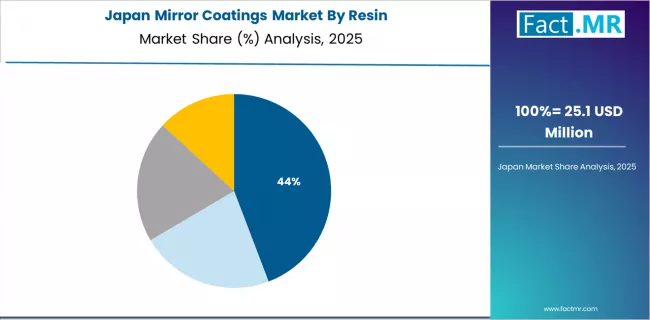
The market in Japan leads in precision manufacturing based on integration with advanced automotive technologies and high-quality architectural standards for residential and commercial applications. The country shows strong potential with a CAGR of 5.3% through 2035, driven by sophisticated manufacturing capabilities and systematic emphasis on quality control in major regions, including Tokyo, Osaka, Nagoya, and Fukuoka.
Japanese manufacturers are adopting precision coating technologies and rigorous quality assurance protocols for automotive mirror production, particularly in advanced driver assistance systems and integrated display applications demanding optical clarity and durability. Distribution channels through automotive supply networks and premium architectural glass distributors expand coverage across quality-focused market segments and specification communities.
Leading market segments:
- Automotive mirror production in major manufacturing centers implementing advanced coating systems for heated mirrors and camera-integrated displays
- Precision optical requirements supporting automotive safety systems and emerging autonomous vehicle sensor integration applications
- High-quality residential projects emphasizing premium bathroom fixtures and architectural mirror installations in luxury housing developments
- Commercial construction including office buildings and retail facilities requiring quality architectural mirrors and decorative glass applications
What Positions South Korea for Automotive Innovation Leadership?
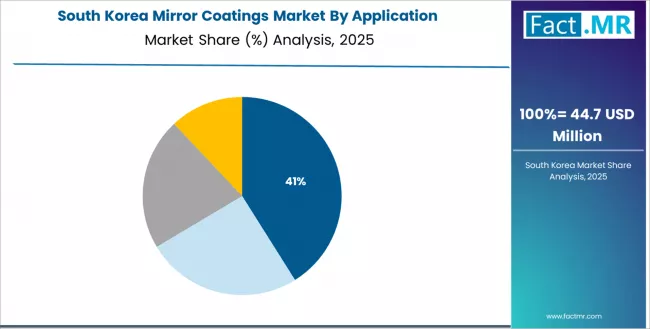
In major industrial regions including Seoul, Busan, Ulsan, and Gwangju, manufacturers are implementing advanced mirror coating solutions through automotive production facilities and commercial construction projects, with documented capabilities showing integration of smart technologies and premium surface treatments. The market shows steady growth potential with a CAGR of 5.2% through 2035, linked to ongoing automotive industry strength, smart city development programs, and growing emphasis on premium commercial applications in major metropolitan regions.
Manufacturers are adopting specialized coating technologies and functional surface treatments to enhance automotive mirror performance while supporting commercial construction projects requiring contemporary architectural finishes. The country's automotive manufacturing excellence creates ongoing opportunities for innovative mirror coatings that differentiate through technology integration and quality standards.
Market development factors:
- Automotive industry leadership through Hyundai, Kia, and component suppliers requiring advanced mirror coatings for domestic and export markets
- Premium commercial applications emphasizing high-end office buildings, luxury hotels, and retail developments incorporating quality architectural mirrors
- Smart city initiatives in Seoul, Busan, and Incheon supporting building automation and integrated mirror technologies
- Technology integration including heated mirrors, auto-dimming systems, and display-integrated automotive mirrors requiring specialized coating formulations
How does USA Show Energy Efficiency Leadership?
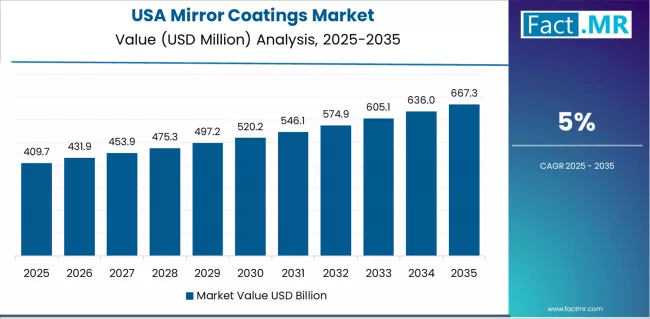
USA’s market expansion is driven by diverse initiatives, including energy-efficient building construction emphasizing LEED certification and automotive industry innovation in advanced mirror technologies. The country demonstrates solid growth with a CAGR of 5.0% through 2035, supported by green building movement strength and continuous automotive technology advancement across major markets.
American building professionals face implementation considerations related to sustainable material selection and performance verification, requiring coating suppliers to demonstrate clear environmental credentials and comprehensive testing documentation. However, established renovation market activity and automotive manufacturing presence create stable baseline demand for mirror coatings, particularly among commercial construction projects and automotive OEM suppliers where sustainability goals and technical specifications drive purchasing decisions and long-term partnerships.
Market characteristics:
- LEED certification programs and green building standards driving low-VOC coating adoption across commercial and institutional construction
- Renovation market strength supporting residential bathroom remodeling and commercial building upgrades requiring mirror replacement
- Automotive industry innovation in advanced mirror systems including camera integration, display technologies, and connectivity features
- Regional variations between strong construction markets in Sun Belt states and renovation-focused activity in Northeast and Midwest regions
What Characterizes Saudi Arabia's Market Development?
In major urban centers including Riyadh, Jeddah, Dammam, and Makkah, the adoption of mirror coating solutions is expanding across luxury residential developments, commercial construction projects, and solar energy infrastructure, driven by urban infrastructure investments and economic diversification initiatives. The market demonstrates solid growth potential with a CAGR of 4.9% through 2035, linked to comprehensive Vision 2030 development programs and increasing focus on renewable energy and sustainable urban development in major cities.
Saudi developers and contractors are implementing quality architectural finishes and modern building systems to enhance project competitiveness while meeting international standards and attracting investment. The country's emphasis on high-end construction creates ongoing demand for premium mirror products, while solar energy initiatives drive specialized coating requirements for concentrated solar power installations.
Key development areas:
- Urban infrastructure development through mega-projects including NEOM, Red Sea Project, and Qiddiya supporting large-scale construction material demand
- Solar energy projects including concentrated solar power plants requiring precision mirror coatings for heliostat and collector systems
- High-end commercial development emphasizing luxury hotels, premium office towers, and retail destinations incorporating quality architectural mirrors
- Residential construction including luxury villas and high-rise apartments requiring premium bathroom fixtures and decorative mirror applications
Europe Market Split by Country
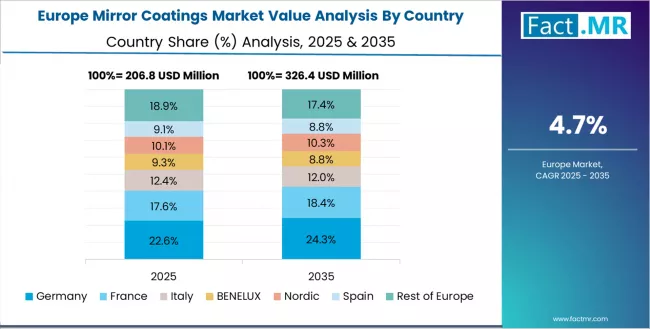
The mirror coatings market in Europe is projected to grow from USD 265.4 million in 2025 to USD 462.8 million by 2035, registering a CAGR of 5.4% over the forecast period. Germany is expected to maintain its leadership position with a 29.6% market share in 2025, adjusting to 29.2% by 2035, supported by its extensive automotive manufacturing excellence, architectural glass industry capabilities, and comprehensive environmental compliance frameworks serving European markets.
UK follows with a 18.4% share in 2025, projected to reach 18.7% by 2035, driven by renovation market activity and smart mirror technology adoption in residential and commercial applications. France holds a 16.8% share in 2025, expected to maintain 17.1% by 2035 through continued architectural innovation and automotive sector presence.
Italy commands a 14.7% share, while Spain accounts for 12.3% in 2025. The rest of Europe region is anticipated to gain momentum, expanding its collective share from 8.2% to 8.8% by 2035, attributed to increasing mirror coating adoption in Nordic countries and emerging Eastern European construction markets implementing modern building practices.
Competitive Landscape of the Mirror Coatings Market
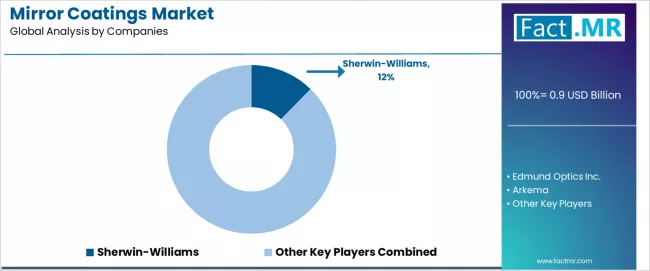
The mirror coatings market features approximately 15-20 meaningful players with moderate concentration, where the top company, Sherwin-Williams, controls 12.3% of the global market share through established brand recognition, comprehensive product portfolios, and extensive distribution networks. Competition centers on formulation innovation, environmental compliance, and technical service capabilities rather than price competition alone.
Market leaders include Sherwin-Williams, which maintains competitive advantages through global coating expertise, comprehensive architectural and industrial product portfolios, and extensive technical support infrastructure serving glass processors and building professionals, creating high customer confidence among mirror manufacturers seeking reliable coating solutions. This company leverages decades of coating technology development and application expertise to defend market positions while advancing water-based formulations and functional coating innovations.
Challengers encompass specialized optical coatings manufacturers including Edmund Optics Inc., JENOPTIK AG, and Guardian Industries, which compete through precision coating technologies and strong presence in automotive and solar applications through technical expertise and quality assurance programs. Chemical companies including Arkema and specialty coating innovators including Pearl Nano and Diamon-Fusion International, Inc. focus on specific technology platforms or market segments, offering differentiated capabilities in nanotechnology-based coatings, protective treatments, and functional surface modifications.
Emerging coating technology companies and regional manufacturers create competitive pressure through novel formulation approaches and cost-competitive offerings, particularly in high-growth markets including China and India where manufacturing scale provides advantages in serving price-sensitive construction segments and rapidly growing mirror production capacity.
Market dynamics favor companies that combine formulation expertise with technical support and customer collaboration capabilities that address complete application cycles from formulation development through manufacturing optimization. Strategic emphasis on environmental compliance, functional coating development, and market-specific formulation enables differentiation in increasingly regulated and performance-demanding mirror coating segments across developed and emerging markets.
Global Mirror Coatings Market — Stakeholder Contribution Framework
Mirror coatings represent a critical specialty coating category that enables glass manufacturers, architects, and building contractors across residential construction, commercial developments, and industrial applications to deliver durable reflective surfaces and achieve long-lasting performance while protecting mirror substrates, typically providing targeted advantages including corrosion resistance, enhanced adhesion, and UV stability through multi-layer protective systems compared to traditional silvering processes alone while ensuring environmental compliance and consistent optical quality.
With the market projected to grow from USD 0.86 billion in 2025 to USD 1.46 billion by 2035 at a 5.4% CAGR, these solutions offer compelling advantages for architectural applications, automotive manufacturing, and diverse reflective surface requirements across global construction and industrial systems. Scaling market penetration and sustainable formulation requires coordinated action across environmental regulations, industry quality standards, coating manufacturers, glass processors, and green building initiatives.
How Could Governments Spur Local Development and Adoption?
- Green Building Programs: Include low-VOC coating requirements in sustainable building certifications, providing clear guidance for environmental compliance and supporting innovation in water-based formulation technologies.
- Tax Policy & Environmental Incentives: Implement favorable treatment for manufacturers adopting water-based coating systems, provide tax incentives for companies investing in emission control equipment and sustainable production processes, and establish structures encouraging green building material adoption.
- Regulatory Framework Development: Create harmonized VOC emission standards and coating performance specifications across jurisdictions, establish clear testing protocols and certification requirements, and develop international alignment facilitating cross-border product acceptance.
- Infrastructure & Skills Development: Fund technical training programs for coating applicators and quality control personnel, invest in testing laboratory capacity supporting product certification, and establish educational initiatives improving coating application quality.
- Innovation & Technology Support: Establish public-private partnerships for advanced coating research, support academic-industry collaborations investigating nanotechnology and functional surfaces, and create regulatory environments encouraging sustainable coating innovation.
How Could Industry Bodies Support Market Development?
- Technical Standards & Specifications: Define standardized performance criteria for mirror coatings across different end-use applications, establish universal testing protocols for adhesion, corrosion resistance, and durability, and create application guideline databases that manufacturers can reference for quality assurance.
- Market Education & Best Practices: Lead messaging demonstrating mirror coating benefits, emphasizing durability advantages, environmental compliance options, and proper application techniques compared to conventional protective systems.
- Environmental & Safety Standards: Develop comprehensive guidelines for VOC management, workplace safety, and waste disposal ensuring environmental protection and worker health across coating manufacturing and application operations.
- Professional Development: Run certification programs for coating applicators, formulation chemists, and quality managers on optimizing mirror coating performance, environmental compliance, and application quality in diverse manufacturing environments.
How Could Manufacturers and Coating Producers Strengthen the Ecosystem?
- Advanced Formulation Development: Develop next-generation mirror coating systems with enhanced environmental profiles, improved functional properties, and specialized characteristics that advance protective performance while meeting evolving regulatory requirements.
- Technical Support Programs: Provide comprehensive application training, troubleshooting assistance, and process optimization services helping glass manufacturers achieve consistent coating quality aligned with product specifications.
- Sustainability Initiatives: Offer low-VOC formulations, recyclable packaging, and life cycle assessment documentation supporting customer sustainability goals and green building certification requirements.
- Research & Innovation Networks: Build comprehensive R&D capabilities, collaborative testing programs, and performance validation systems ensuring mirror coatings maintain high quality standards and address evolving market needs.
How Could Glass Manufacturers and Processors Navigate the Market?
- Quality Assurance Integration: Incorporate validated coating application processes, comprehensive testing protocols, and statistical process control ensuring consistent mirror quality across production operations.
- Environmental Compliance: Establish emission monitoring systems, waste management procedures, and regulatory reporting protocols meeting VOC limits and environmental discharge requirements.
- Application Optimization: Implement efficient coating utilization procedures, equipment maintenance programs, and operator training minimizing defects and optimizing production efficiency.
- Product Development: Develop specialized mirror products incorporating functional coatings, custom finishes, and value-added features supporting market differentiation and premium positioning.
How Could Investors and Financial Enablers Unlock Value?
- Market Leader Investment: Provide growth capital for established companies like SHERWIN-WILLIAMS and specialty coating manufacturers to fund capacity expansion, R&D programs, and geographic market development.
- Technology Innovation Financing: Back companies developing nanotechnology coatings, smart mirror systems, and sustainable formulation technologies advancing industry performance and environmental standards.
- Market Expansion Funding: Finance manufacturing facility establishment and distribution network development in high-growth regions including Asia Pacific, supporting localization strategies addressing regional market requirements.
- Sustainability Investment: Support companies implementing water-based coating transitions, emission reduction technologies, and circular economy practices enhancing environmental performance through technology-enabled manufacturing.
Key Players in the Mirror Coatings Market
- Sherwin-Williams
- Edmund Optics Inc.
- Arkema
- Pearl Nano
- Diamon-Fusion International, Inc.
- FENZI S.p.A.
- General Optics (Asia) Limited
- Guardian Industries
- JENOPTIK AG
- North America Coating Laboratories
- AccuCoat Inc.
- CASIX, Inc.
- Abrisa Technologies
Scope of the Report
| Items | Values |
|---|---|
| Quantitative Units | USD 0.86 billion |
| Resin | Polyurethane, Epoxy, Acrylic, Others |
| Application | Water-based Coatings, Solvent-based Coatings, Nanotechnology-based Coatings, Others |
| End Use | Architectural, Automotive & Transportation, Decorative, Solar Power, Others |
| Regions Covered | Asia Pacific, Europe, North America, Latin America, Middle East & Africa |
| Country Covered | China, USA, and 40+ countries across regions |
| Key Companies Profiled | SHERWIN-WILLIAMS, Edmund Optics Inc., Arkema, Pearl Nano, Diamon-Fusion International, Inc., FENZI S.p.A., General Optics (Asia) Limited, Guardian Industries, JENOPTIK AG, North America Coating Laboratories, AccuCoat Inc., CASIX, Inc., Abrisa Technologies |
| Additional Attributes | Dollar sales by resin and application categories, regional adoption trends across Asia Pacific, Europe, and North America, competitive landscape with coating manufacturers and glass processors, product specifications and performance requirements, integration with architectural design and automotive manufacturing systems, innovations in water-based formulations and nanotechnology applications, and development of specialized coatings with environmental compliance and functional surface capabilities. |
Mirror Coatings Market by Segments
-
Resin :
- Polyurethane
- Epoxy
- Acrylic
- Others
-
Application :
- Water-based Coatings
- Solvent-based Coatings
- Nanotechnology-based Coatings
- Others
-
End Use :
- Architectural
- Automotive & Transportation
- Decorative
- Solar Power
- Others
-
Region :
- Asia Pacific
- China
- Japan
- India
- South Korea
- Australia
- Thailand
- Rest of Asia Pacific
- Europe
- Germany
- UK
- France
- Italy
- Spain
- Denmark
- Sweden
- Norway
- Rest of Europe
- North America
- USA
- Canada
- Mexico
- Latin America
- Brazil
- Argentina
- Rest of Latin America
- Middle East & Africa
- South Africa
- Saudi Arabia
- UAE
- Kuwait
- Rest of Middle East & Africa
- Asia Pacific
Table of Content
- Executive Summary
- Global Market Outlook
- Demand to side Trends
- Supply to side Trends
- Technology Roadmap Analysis
- Analysis and Recommendations
- Market Overview
- Market Coverage / Taxonomy
- Market Definition / Scope / Limitations
- Market Background
- Market Dynamics
- Drivers
- Restraints
- Opportunity
- Trends
- Scenario Forecast
- Demand in Optimistic Scenario
- Demand in Likely Scenario
- Demand in Conservative Scenario
- Opportunity Map Analysis
- Product Life Cycle Analysis
- Supply Chain Analysis
- Investment Feasibility Matrix
- Value Chain Analysis
- PESTLE and Porter’s Analysis
- Regulatory Landscape
- Regional Parent Market Outlook
- Production and Consumption Statistics
- Import and Export Statistics
- Market Dynamics
- Global Market Analysis 2020 to 2024 and Forecast, 2025 to 2035
- Historical Market Size Value (USD Million) Analysis, 2020 to 2024
- Current and Future Market Size Value (USD Million) Projections, 2025 to 2035
- Y to o to Y Growth Trend Analysis
- Absolute $ Opportunity Analysis
- Global Market Pricing Analysis 2020 to 2024 and Forecast 2025 to 2035
- Global Market Analysis 2020 to 2024 and Forecast 2025 to 2035, By Resin
- Introduction / Key Findings
- Historical Market Size Value (USD Million) Analysis By Resin, 2020 to 2024
- Current and Future Market Size Value (USD Million) Analysis and Forecast By Resin, 2025 to 2035
- Polyurethane
- Epoxy
- Acrylic
- Others
- Y to o to Y Growth Trend Analysis By Resin, 2020 to 2024
- Absolute $ Opportunity Analysis By Resin, 2025 to 2035
- Global Market Analysis 2020 to 2024 and Forecast 2025 to 2035, By Application
- Introduction / Key Findings
- Historical Market Size Value (USD Million) Analysis By Application, 2020 to 2024
- Current and Future Market Size Value (USD Million) Analysis and Forecast By Application, 2025 to 2035
- Water-based Coatings
- Solvent-based Coatings
- Nanotechnology-based Coatings
- Others
- Y to o to Y Growth Trend Analysis By Application, 2020 to 2024
- Absolute $ Opportunity Analysis By Application, 2025 to 2035
- Global Market Analysis 2020 to 2024 and Forecast 2025 to 2035, By End-Use
- Introduction / Key Findings
- Historical Market Size Value (USD Million) Analysis By End-Use, 2020 to 2024
- Current and Future Market Size Value (USD Million) Analysis and Forecast By End-Use, 2025 to 2035
- Architectural
- Automotive & Transportation
- Decorative
- Solar Power
- Others
- Y to o to Y Growth Trend Analysis By End-Use, 2020 to 2024
- Absolute $ Opportunity Analysis By End-Use, 2025 to 2035
- Global Market Analysis 2020 to 2024 and Forecast 2025 to 2035, By Region
- Introduction
- Historical Market Size Value (USD Million) Analysis By Region, 2020 to 2024
- Current Market Size Value (USD Million) Analysis and Forecast By Region, 2025 to 2035
- North America
- Latin America
- Western Europe
- Eastern Europe
- East Asia
- South Asia and Pacific
- Middle East & Africa
- Market Attractiveness Analysis By Region
- North America Market Analysis 2020 to 2024 and Forecast 2025 to 2035, By Country
- Historical Market Size Value (USD Million) Trend Analysis By Market Taxonomy, 2020 to 2024
- Market Size Value (USD Million) Forecast By Market Taxonomy, 2025 to 2035
- By Country
- USA
- Canada
- Mexico
- By Resin
- By Application
- By End-Use
- By Country
- Market Attractiveness Analysis
- By Country
- By Resin
- By Application
- By End-Use
- Key Takeaways
- Latin America Market Analysis 2020 to 2024 and Forecast 2025 to 2035, By Country
- Historical Market Size Value (USD Million) Trend Analysis By Market Taxonomy, 2020 to 2024
- Market Size Value (USD Million) Forecast By Market Taxonomy, 2025 to 2035
- By Country
- Brazil
- Chile
- Rest of Latin America
- By Resin
- By Application
- By End-Use
- By Country
- Market Attractiveness Analysis
- By Country
- By Resin
- By Application
- By End-Use
- Key Takeaways
- Western Europe Market Analysis 2020 to 2024 and Forecast 2025 to 2035, By Country
- Historical Market Size Value (USD Million) Trend Analysis By Market Taxonomy, 2020 to 2024
- Market Size Value (USD Million) Forecast By Market Taxonomy, 2025 to 2035
- By Country
- Germany
- UK
- Italy
- Spain
- France
- Nordic
- BENELUX
- Rest of Western Europe
- By Resin
- By Application
- By End-Use
- By Country
- Market Attractiveness Analysis
- By Country
- By Resin
- By Application
- By End-Use
- Key Takeaways
- Eastern Europe Market Analysis 2020 to 2024 and Forecast 2025 to 2035, By Country
- Historical Market Size Value (USD Million) Trend Analysis By Market Taxonomy, 2020 to 2024
- Market Size Value (USD Million) Forecast By Market Taxonomy, 2025 to 2035
- By Country
- Russia
- Poland
- Hungary
- Balkan & Baltic
- Rest of Eastern Europe
- By Resin
- By Application
- By End-Use
- By Country
- Market Attractiveness Analysis
- By Country
- By Resin
- By Application
- By End-Use
- Key Takeaways
- East Asia Market Analysis 2020 to 2024 and Forecast 2025 to 2035, By Country
- Historical Market Size Value (USD Million) Trend Analysis By Market Taxonomy, 2020 to 2024
- Market Size Value (USD Million) Forecast By Market Taxonomy, 2025 to 2035
- By Country
- China
- Japan
- South Korea
- By Resin
- By Application
- By End-Use
- By Country
- Market Attractiveness Analysis
- By Country
- By Resin
- By Application
- By End-Use
- Key Takeaways
- South Asia and Pacific Market Analysis 2020 to 2024 and Forecast 2025 to 2035, By Country
- Historical Market Size Value (USD Million) Trend Analysis By Market Taxonomy, 2020 to 2024
- Market Size Value (USD Million) Forecast By Market Taxonomy, 2025 to 2035
- By Country
- India
- ASEAN
- Australia & New Zealand
- Rest of South Asia and Pacific
- By Resin
- By Application
- By End-Use
- By Country
- Market Attractiveness Analysis
- By Country
- By Resin
- By Application
- By End-Use
- Key Takeaways
- Middle East & Africa Market Analysis 2020 to 2024 and Forecast 2025 to 2035, By Country
- Historical Market Size Value (USD Million) Trend Analysis By Market Taxonomy, 2020 to 2024
- Market Size Value (USD Million) Forecast By Market Taxonomy, 2025 to 2035
- By Country
- Kingdom of Saudi Arabia
- Other GCC Countries
- Turkiye
- South Africa
- Other African Union
- Rest of Middle East & Africa
- By Resin
- By Application
- By End-Use
- By Country
- Market Attractiveness Analysis
- By Country
- By Resin
- By Application
- By End-Use
- Key Takeaways
- Key Countries Market Analysis
- USA
- Pricing Analysis
- Market Share Analysis, 2024
- By Resin
- By Application
- By End-Use
- Canada
- Pricing Analysis
- Market Share Analysis, 2024
- By Resin
- By Application
- By End-Use
- Mexico
- Pricing Analysis
- Market Share Analysis, 2024
- By Resin
- By Application
- By End-Use
- Brazil
- Pricing Analysis
- Market Share Analysis, 2024
- By Resin
- By Application
- By End-Use
- Chile
- Pricing Analysis
- Market Share Analysis, 2024
- By Resin
- By Application
- By End-Use
- Germany
- Pricing Analysis
- Market Share Analysis, 2024
- By Resin
- By Application
- By End-Use
- UK
- Pricing Analysis
- Market Share Analysis, 2024
- By Resin
- By Application
- By End-Use
- Italy
- Pricing Analysis
- Market Share Analysis, 2024
- By Resin
- By Application
- By End-Use
- Spain
- Pricing Analysis
- Market Share Analysis, 2024
- By Resin
- By Application
- By End-Use
- France
- Pricing Analysis
- Market Share Analysis, 2024
- By Resin
- By Application
- By End-Use
- India
- Pricing Analysis
- Market Share Analysis, 2024
- By Resin
- By Application
- By End-Use
- ASEAN
- Pricing Analysis
- Market Share Analysis, 2024
- By Resin
- By Application
- By End-Use
- Australia & New Zealand
- Pricing Analysis
- Market Share Analysis, 2024
- By Resin
- By Application
- By End-Use
- China
- Pricing Analysis
- Market Share Analysis, 2024
- By Resin
- By Application
- By End-Use
- Japan
- Pricing Analysis
- Market Share Analysis, 2024
- By Resin
- By Application
- By End-Use
- South Korea
- Pricing Analysis
- Market Share Analysis, 2024
- By Resin
- By Application
- By End-Use
- Russia
- Pricing Analysis
- Market Share Analysis, 2024
- By Resin
- By Application
- By End-Use
- Poland
- Pricing Analysis
- Market Share Analysis, 2024
- By Resin
- By Application
- By End-Use
- Hungary
- Pricing Analysis
- Market Share Analysis, 2024
- By Resin
- By Application
- By End-Use
- Kingdom of Saudi Arabia
- Pricing Analysis
- Market Share Analysis, 2024
- By Resin
- By Application
- By End-Use
- Turkiye
- Pricing Analysis
- Market Share Analysis, 2024
- By Resin
- By Application
- By End-Use
- South Africa
- Pricing Analysis
- Market Share Analysis, 2024
- By Resin
- By Application
- By End-Use
- USA
- Market Structure Analysis
- Competition Dashboard
- Competition Benchmarking
- Market Share Analysis of Top Players
- By Regional
- By Resin
- By Application
- By End-Use
- Competition Analysis
- Competition Deep Dive
- Sherwin-Williams
- Overview
- Product Portfolio
- Profitability by Market Segments (Product/Age /Sales Channel/Region)
- Sales Footprint
- Strategy Overview
- Marketing Strategy
- Product Strategy
- Channel Strategy
- Edmund Optics Inc.
- Arkema
- Pearl Nano
- Diamon-Fusion International, Inc.
- FENZI S.p.A.
- General Optics (Asia) Limited
- Guardian Industries
- JENOPTIK AG
- North America Coating Laboratories
- AccuCoat Inc.
- CASIX, Inc.
- Abrisa Technologies
- Sherwin-Williams
- Competition Deep Dive
- Assumptions & Acronyms Used
- Research Methodology
List Of Table
- Table 1: Global Market Value (USD Million) Forecast by Region, 2020 to 2035
- Table 2: Global Market Value (USD Million) Forecast by Resin, 2020 to 2035
- Table 3: Global Market Value (USD Million) Forecast by Application, 2020 to 2035
- Table 4: Global Market Value (USD Million) Forecast by End-Use, 2020 to 2035
- Table 5: North America Market Value (USD Million) Forecast by Country, 2020 to 2035
- Table 6: North America Market Value (USD Million) Forecast by Resin, 2020 to 2035
- Table 7: North America Market Value (USD Million) Forecast by Application, 2020 to 2035
- Table 8: North America Market Value (USD Million) Forecast by End-Use, 2020 to 2035
- Table 9: Latin America Market Value (USD Million) Forecast by Country, 2020 to 2035
- Table 10: Latin America Market Value (USD Million) Forecast by Resin, 2020 to 2035
- Table 11: Latin America Market Value (USD Million) Forecast by Application, 2020 to 2035
- Table 12: Latin America Market Value (USD Million) Forecast by End-Use, 2020 to 2035
- Table 13: Western Europe Market Value (USD Million) Forecast by Country, 2020 to 2035
- Table 14: Western Europe Market Value (USD Million) Forecast by Resin, 2020 to 2035
- Table 15: Western Europe Market Value (USD Million) Forecast by Application, 2020 to 2035
- Table 16: Western Europe Market Value (USD Million) Forecast by End-Use, 2020 to 2035
- Table 17: Eastern Europe Market Value (USD Million) Forecast by Country, 2020 to 2035
- Table 18: Eastern Europe Market Value (USD Million) Forecast by Resin, 2020 to 2035
- Table 19: Eastern Europe Market Value (USD Million) Forecast by Application, 2020 to 2035
- Table 20: Eastern Europe Market Value (USD Million) Forecast by End-Use, 2020 to 2035
- Table 21: East Asia Market Value (USD Million) Forecast by Country, 2020 to 2035
- Table 22: East Asia Market Value (USD Million) Forecast by Resin, 2020 to 2035
- Table 23: East Asia Market Value (USD Million) Forecast by Application, 2020 to 2035
- Table 24: East Asia Market Value (USD Million) Forecast by End-Use, 2020 to 2035
- Table 25: South Asia and Pacific Market Value (USD Million) Forecast by Country, 2020 to 2035
- Table 26: South Asia and Pacific Market Value (USD Million) Forecast by Resin, 2020 to 2035
- Table 27: South Asia and Pacific Market Value (USD Million) Forecast by Application, 2020 to 2035
- Table 28: South Asia and Pacific Market Value (USD Million) Forecast by End-Use, 2020 to 2035
- Table 29: Middle East & Africa Market Value (USD Million) Forecast by Country, 2020 to 2035
- Table 30: Middle East & Africa Market Value (USD Million) Forecast by Resin, 2020 to 2035
- Table 31: Middle East & Africa Market Value (USD Million) Forecast by Application, 2020 to 2035
- Table 32: Middle East & Africa Market Value (USD Million) Forecast by End-Use, 2020 to 2035
List Of Figures
- Figure 1: Global Market Pricing Analysis
- Figure 2: Global Market Value (USD Million) Forecast 2020 to 2035
- Figure 3: Global Market Value Share and BPS Analysis by Resin, 2025 and 2035
- Figure 4: Global Market Y to o to Y Growth Comparison by Resin, 2025 to 2035
- Figure 5: Global Market Attractiveness Analysis by Resin
- Figure 6: Global Market Value Share and BPS Analysis by Application, 2025 and 2035
- Figure 7: Global Market Y to o to Y Growth Comparison by Application, 2025 to 2035
- Figure 8: Global Market Attractiveness Analysis by Application
- Figure 9: Global Market Value Share and BPS Analysis by End-Use, 2025 and 2035
- Figure 10: Global Market Y to o to Y Growth Comparison by End-Use, 2025 to 2035
- Figure 11: Global Market Attractiveness Analysis by End-Use
- Figure 12: Global Market Value (USD Million) Share and BPS Analysis by Region, 2025 and 2035
- Figure 13: Global Market Y to o to Y Growth Comparison by Region, 2025 to 2035
- Figure 14: Global Market Attractiveness Analysis by Region
- Figure 15: North America Market Incremental Dollar Opportunity, 2025 to 2035
- Figure 16: Latin America Market Incremental Dollar Opportunity, 2025 to 2035
- Figure 17: Western Europe Market Incremental Dollar Opportunity, 2025 to 2035
- Figure 18: Eastern Europe Market Incremental Dollar Opportunity, 2025 to 2035
- Figure 19: East Asia Market Incremental Dollar Opportunity, 2025 to 2035
- Figure 20: South Asia and Pacific Market Incremental Dollar Opportunity, 2025 to 2035
- Figure 21: Middle East & Africa Market Incremental Dollar Opportunity, 2025 to 2035
- Figure 22: North America Market Value Share and BPS Analysis by Country, 2025 and 2035
- Figure 23: North America Market Value Share and BPS Analysis by Resin, 2025 and 2035
- Figure 24: North America Market Y to o to Y Growth Comparison by Resin, 2025 to 2035
- Figure 25: North America Market Attractiveness Analysis by Resin
- Figure 26: North America Market Value Share and BPS Analysis by Application, 2025 and 2035
- Figure 27: North America Market Y to o to Y Growth Comparison by Application, 2025 to 2035
- Figure 28: North America Market Attractiveness Analysis by Application
- Figure 29: North America Market Value Share and BPS Analysis by End-Use, 2025 and 2035
- Figure 30: North America Market Y to o to Y Growth Comparison by End-Use, 2025 to 2035
- Figure 31: North America Market Attractiveness Analysis by End-Use
- Figure 32: Latin America Market Value Share and BPS Analysis by Country, 2025 and 2035
- Figure 33: Latin America Market Value Share and BPS Analysis by Resin, 2025 and 2035
- Figure 34: Latin America Market Y to o to Y Growth Comparison by Resin, 2025 to 2035
- Figure 35: Latin America Market Attractiveness Analysis by Resin
- Figure 36: Latin America Market Value Share and BPS Analysis by Application, 2025 and 2035
- Figure 37: Latin America Market Y to o to Y Growth Comparison by Application, 2025 to 2035
- Figure 38: Latin America Market Attractiveness Analysis by Application
- Figure 39: Latin America Market Value Share and BPS Analysis by End-Use, 2025 and 2035
- Figure 40: Latin America Market Y to o to Y Growth Comparison by End-Use, 2025 to 2035
- Figure 41: Latin America Market Attractiveness Analysis by End-Use
- Figure 42: Western Europe Market Value Share and BPS Analysis by Country, 2025 and 2035
- Figure 43: Western Europe Market Value Share and BPS Analysis by Resin, 2025 and 2035
- Figure 44: Western Europe Market Y to o to Y Growth Comparison by Resin, 2025 to 2035
- Figure 45: Western Europe Market Attractiveness Analysis by Resin
- Figure 46: Western Europe Market Value Share and BPS Analysis by Application, 2025 and 2035
- Figure 47: Western Europe Market Y to o to Y Growth Comparison by Application, 2025 to 2035
- Figure 48: Western Europe Market Attractiveness Analysis by Application
- Figure 49: Western Europe Market Value Share and BPS Analysis by End-Use, 2025 and 2035
- Figure 50: Western Europe Market Y to o to Y Growth Comparison by End-Use, 2025 to 2035
- Figure 51: Western Europe Market Attractiveness Analysis by End-Use
- Figure 52: Eastern Europe Market Value Share and BPS Analysis by Country, 2025 and 2035
- Figure 53: Eastern Europe Market Value Share and BPS Analysis by Resin, 2025 and 2035
- Figure 54: Eastern Europe Market Y to o to Y Growth Comparison by Resin, 2025 to 2035
- Figure 55: Eastern Europe Market Attractiveness Analysis by Resin
- Figure 56: Eastern Europe Market Value Share and BPS Analysis by Application, 2025 and 2035
- Figure 57: Eastern Europe Market Y to o to Y Growth Comparison by Application, 2025 to 2035
- Figure 58: Eastern Europe Market Attractiveness Analysis by Application
- Figure 59: Eastern Europe Market Value Share and BPS Analysis by End-Use, 2025 and 2035
- Figure 60: Eastern Europe Market Y to o to Y Growth Comparison by End-Use, 2025 to 2035
- Figure 61: Eastern Europe Market Attractiveness Analysis by End-Use
- Figure 62: East Asia Market Value Share and BPS Analysis by Country, 2025 and 2035
- Figure 63: East Asia Market Value Share and BPS Analysis by Resin, 2025 and 2035
- Figure 64: East Asia Market Y to o to Y Growth Comparison by Resin, 2025 to 2035
- Figure 65: East Asia Market Attractiveness Analysis by Resin
- Figure 66: East Asia Market Value Share and BPS Analysis by Application, 2025 and 2035
- Figure 67: East Asia Market Y to o to Y Growth Comparison by Application, 2025 to 2035
- Figure 68: East Asia Market Attractiveness Analysis by Application
- Figure 69: East Asia Market Value Share and BPS Analysis by End-Use, 2025 and 2035
- Figure 70: East Asia Market Y to o to Y Growth Comparison by End-Use, 2025 to 2035
- Figure 71: East Asia Market Attractiveness Analysis by End-Use
- Figure 72: South Asia and Pacific Market Value Share and BPS Analysis by Country, 2025 and 2035
- Figure 73: South Asia and Pacific Market Value Share and BPS Analysis by Resin, 2025 and 2035
- Figure 74: South Asia and Pacific Market Y to o to Y Growth Comparison by Resin, 2025 to 2035
- Figure 75: South Asia and Pacific Market Attractiveness Analysis by Resin
- Figure 76: South Asia and Pacific Market Value Share and BPS Analysis by Application, 2025 and 2035
- Figure 77: South Asia and Pacific Market Y to o to Y Growth Comparison by Application, 2025 to 2035
- Figure 78: South Asia and Pacific Market Attractiveness Analysis by Application
- Figure 79: South Asia and Pacific Market Value Share and BPS Analysis by End-Use, 2025 and 2035
- Figure 80: South Asia and Pacific Market Y to o to Y Growth Comparison by End-Use, 2025 to 2035
- Figure 81: South Asia and Pacific Market Attractiveness Analysis by End-Use
- Figure 82: Middle East & Africa Market Value Share and BPS Analysis by Country, 2025 and 2035
- Figure 83: Middle East & Africa Market Value Share and BPS Analysis by Resin, 2025 and 2035
- Figure 84: Middle East & Africa Market Y to o to Y Growth Comparison by Resin, 2025 to 2035
- Figure 85: Middle East & Africa Market Attractiveness Analysis by Resin
- Figure 86: Middle East & Africa Market Value Share and BPS Analysis by Application, 2025 and 2035
- Figure 87: Middle East & Africa Market Y to o to Y Growth Comparison by Application, 2025 to 2035
- Figure 88: Middle East & Africa Market Attractiveness Analysis by Application
- Figure 89: Middle East & Africa Market Value Share and BPS Analysis by End-Use, 2025 and 2035
- Figure 90: Middle East & Africa Market Y to o to Y Growth Comparison by End-Use, 2025 to 2035
- Figure 91: Middle East & Africa Market Attractiveness Analysis by End-Use
- Figure 92: Global Market - Tier Structure Analysis
- Figure 93: Global Market - Company Share Analysis
- FAQs -
How big is the mirror coatings market in 2025?
The global mirror coatings market is estimated to be valued at USD 0.9 billion in 2025.
What will be the size of mirror coatings market in 2035?
The market size for the mirror coatings market is projected to reach USD 1.5 billion by 2035.
How much will be the mirror coatings market growth between 2025 and 2035?
The mirror coatings market is expected to grow at a 5.4% CAGR between 2025 and 2035.
What are the key product types in the mirror coatings market?
The key product types in mirror coatings market are polyurethane, epoxy, acrylic and others.
Which application segment to contribute significant share in the mirror coatings market in 2025?
In terms of application, water-based coatings segment to command 40.5% share in the mirror coatings market in 2025.